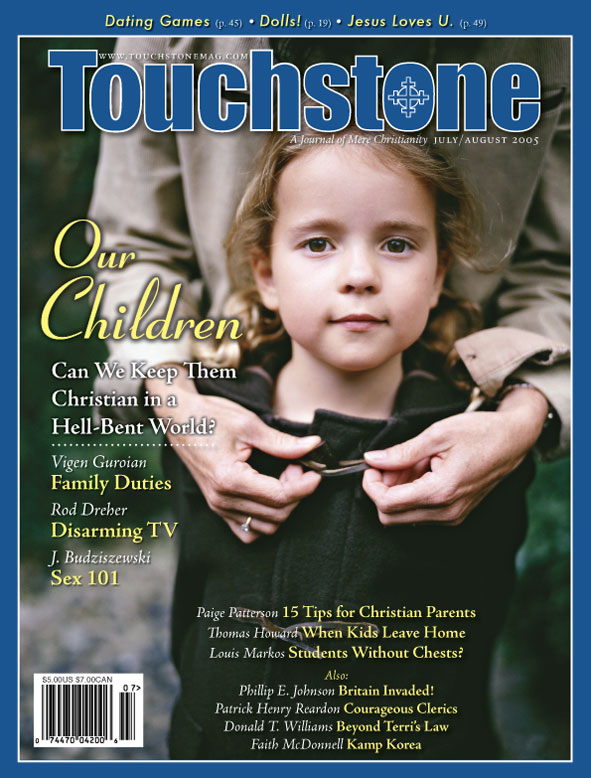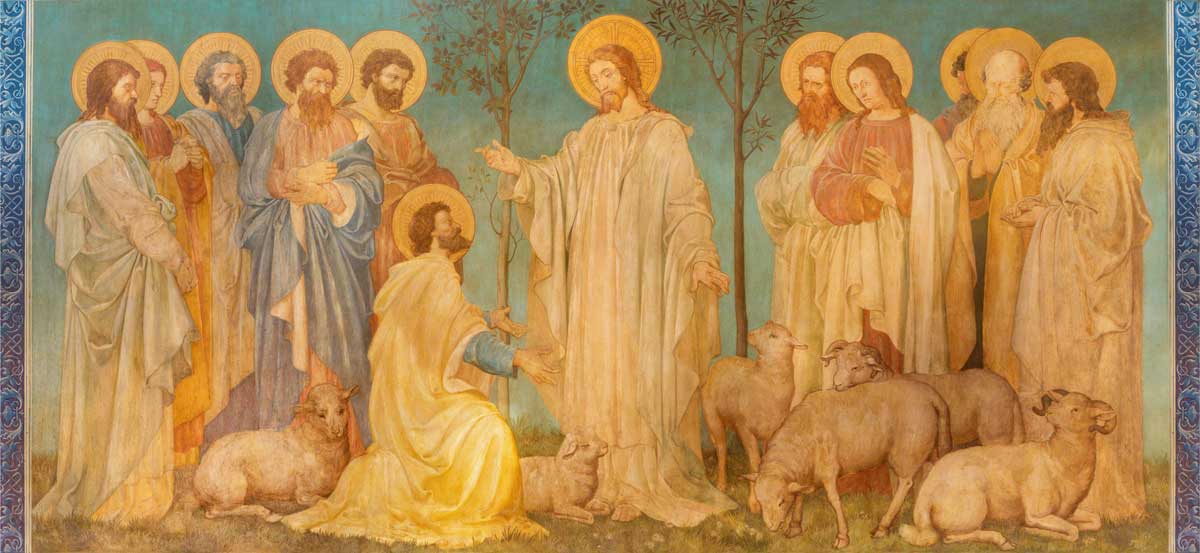Jesus Loves U.
God on the Quad by Naomi Schaefer Riley
God on the Quad: How Religious Colleges and the Missionary Generation
Are Changing America
St. Martin’s Press, 2005
(288 pages, $24.95, hardcover)
reviewed by Joseph M. Knippenberg
Home for me is Blue America,” admits self-described “nice Jewish girl” Naomi Schaefer Riley. “I attended two secular colleges and grew up with a sense that religion, while socially beneficial (in that it provided people with a moral compass they might not otherwise have), was not true.”
Yet though a self-conscious outsider to the world she investigated, her God on the Quad is a serious and sympathetic attempt to describe the current crop of religious college students. Riley is relatively young, a recent (1998) college graduate who has a feel for the kinds of issues her subjects face and interacts with them as a “near peer.” (Full disclosure: I am acquainted with Ms. Riley’s father, who teaches political philosophy at Holy Cross. He and I are members of the same philosophical “sect” or “tribe.”)
In writing the book, Riley visited an impressive array of institutions (twenty in all), from established universities like Brigham Young, Baylor, and Notre Dame to small, new, self-consciously traditional colleges like Christendom, Patrick Henry, and Thomas More College of Liberal Arts, as well as Jewish and Buddhist universities. Showing a healthy skepticism about the efforts of university public relations staffers, she sought out the “dissidents” and “malcontents” as well as the model campus citizens.
There are chapters on individual institutions (BYU, Bob Jones, Notre Dame, California’s Thomas Aquinas College, Baylor, and Yeshiva), as well as on common themes in campus life (like the role of women, “sex, drugs, and rock ’n’ roll,” and the integration of faith and learning).
Missionary Students
The result is a portrait of what Riley calls “the missionary generation,” the “1.3 million [presumably recent] graduates of the nation’s more than seven hundred [presumably most faithful] religious colleges.” I add the qualifiers since Riley nowhere tells us precisely where she gets her numbers.
These young people are, she says, “red through and through”: “They reject the spiritually empty education of secular schools. They refuse to accept the sophisticated ennui of their contemporaries. . . . They rebuff the intellectual relativism of professors and the moral relativism of their peers.” They not only think differently, they act differently:
They don’t spend their college years experimenting with sex or drugs. They marry early and plan ahead for family life. . . . Most dress modestly and don’t drink, use drugs, or smoke. They study hard, leaving little time for sitting in or walking out. Most vote, and a good number join the army. They are also becoming lawyers, doctors, politicians, college professors, businessmen, psychologists, accountants, and philanthropists in the cultural and political centers of the country.
They will, she declares, be “thoughtful and community-minded citizens, whose religious beliefs strengthen the causes of civic commitment, moral decency, and family stability.”
These are bold generalizations, and it would obviously be difficult to prove them conclusively on the basis of her anecdotal evidence. Indeed, her own reporting suggests the problem.
Notre Dame, for example, seems by her account to wink at student alcohol consumption, and its student sexual culture apparently differs from its secular counterparts only by being more monogamous and less oriented to “hooking-up.” About half the students drink at Baylor, a Southern Baptist university (though that number “is about 25 percent less than the national average”), and surveys show that one-third of them are having sex.
In the face of a secular youth culture that celebrates booze and sex, these numbers are not unimpressive (and some of the smaller colleges seem positively monastic), but they don’t quite support her most grandiose claims.
Similarly, while she claims that these students are typically more serious about their studies than are their secular peers, she concedes that she has focused on some of the more academically prestigious religious schools and has not fully explored the anti-intellectual possibilities of pietism and moral and religious activism. She notes that service “has become so popular and time consuming that many religious college administrators and faculty have become concerned it is overtaking academics as a priority for their students,” without considering how this affects her picture of the academic seriousness of religious college students.
Out of the Garden
Riley is at her best in exploring with her near-peers their college, life, and career choices. She offers a plausible explanation, for example, for the culture of early marriage at many of the schools: Their thoughts turn to early marriage partly because easy libidinal outlets are discouraged and partly because they perceive their college lives as a veritable wonderland of like-minded and attractive people, unlike any they have seen before or are likely to see again.
But they are not insular, wishing to spend the rest of their lives in a homogeneous religious “garden” fenced off from the “wilderness” of secular society. They expect to live in and engage with “the world.”
Riley also offers a remarkably sensitive portrait of the young women she encounters. They have, she argues, found “a sophisticated accommodation to modernity,” a “third way” between feminist ideology and the traditionally domestic female role encouraged by many conservative churches. They don’t anxiously try to “have it all”; rather, their “religious beliefs allow them to accept the inevitable trade-off between work and family.” Their calling, they are finding, is complicated, but much more a matter of prayerful discernment than of willful self-assertion.
To her credit, Riley considers a number of threats to the picture she paints, not least the powerful secularizing forces that have affected all but the smallest and most self-consciously orthodox of the religious schools. At Notre Dame, for example, it is not clear that the current generation of committed Roman Catholic faculty (and their fellow travelers), who are influential but not numerically dominant, will be replaced by a cohort willing to sustain their enterprise.
If, as some suggest, in hiring faculty the university treats Catholicism “as an affirmative action category,” a faculty increasingly nominal in its Catholicism may eventually engender a nominally Catholic university. Without a concerted effort, Notre Dame could become as secularized as Georgetown, Fordham, and Boston College.
Riley also wonders about the dalliance of some Evangelical faculties with postmodernism. Some members of the Westmont College faculty have, for example, decided that the best way to address the problem of theodicy is “by viewing ‘reality as socially constructed,’” according to the college’s academic dean. If among Evangelical academics the Christian “narrative community” comes to be regarded as just one among many, and its Book as just one among many, then we have no “missionary generation” to speak of, not to mention no genuine faith in a sovereign God.
Riley also notes the ways some religious colleges have adopted the trends and fads of secular higher education. For example, too many of their efforts to integrate minority students follow the secular student-life playbook, promoting “interest housing” and multicultural programming. We might conclude that administrators should, instead, have reconsidered the teaching of Galatians 3:28, exploring and exploiting the various ways of building the body of Christ through ritual, fellowship, service, and, above all else, study.
“The strong core curricula found at religious schools,” she argues, “may help students see more of the similarities than differences among them.” Although it would be a mistake to call the classroom a chapel, as she does, common inquiry into the world God created is a powerful source of unity.
What Matters
This is an insight one wishes Riley were equipped to take further, but she is self-consciously not a Christian intellectual or pedagogue.
Nevertheless, in describing the differences between institutions that resemble the nearly diabolical fictional college attended by Tom Wolfe’s Charlotte Simmons and the imperfectly executed aspirations of America’s most intellectually and theologically serious religious colleges, Riley points us back to what matters in the education of our successor generations. She shows us something of how our message is being received, thereby indicating what sort of work we still have to do.
By noting, further, the powerful secularizing trends that affect these colleges, she makes us wish and pray all the more for the success of efforts to uphold traditional religious models of higher education, not only at the undergraduate but also at the graduate level. Without the powerful intellectual and spiritual underpinning and formation such institutions can provide, it is difficult for anyone to pursue a religious calling in a world that is at best indifferent and at worst hostile to it.
We may well be in a race between the secularization of American religious higher education and the “missionary generation’s” transformation of American society. Riley hopes that her subjects will win. I fear that religious higher education will lose. Her book provides ample evidence for both our sentiments.
Joseph M. Knippenberg is Professor of Politics and Director of the Rich Foundation Urban Leadership Program at Oglethorpe University in Atlanta, Georgia. He is also an Adjunct Fellow of the Ashbrook Center for Public Affairs, on whose website (www.ashbrook.org) and weblog (www.noleftturns.ashbrook.org) he frequently posts.
bulk subscriptions
Order Touchstone subscriptions in bulk and save $10 per sub! Each subscription includes 6 issues of Touchstone plus full online access to touchstonemag.com—including archives, videos, and pdf downloads of recent issues for only $29.95 each! Great for churches or study groups.
Transactions will be processed on a secure server.
more from the online archives
calling all readers
Please Donate
"There are magazines worth reading but few worth saving . . . Touchstone is just such a magazine."
—Alice von Hildebrand
"Here we do not concede one square millimeter of territory to falsehood, folly, contemporary sentimentality, or fashion. We speak the truth, and let God be our judge. . . . Touchstone is the one committedly Christian conservative journal."
—Anthony Esolen, Touchstone senior editor










